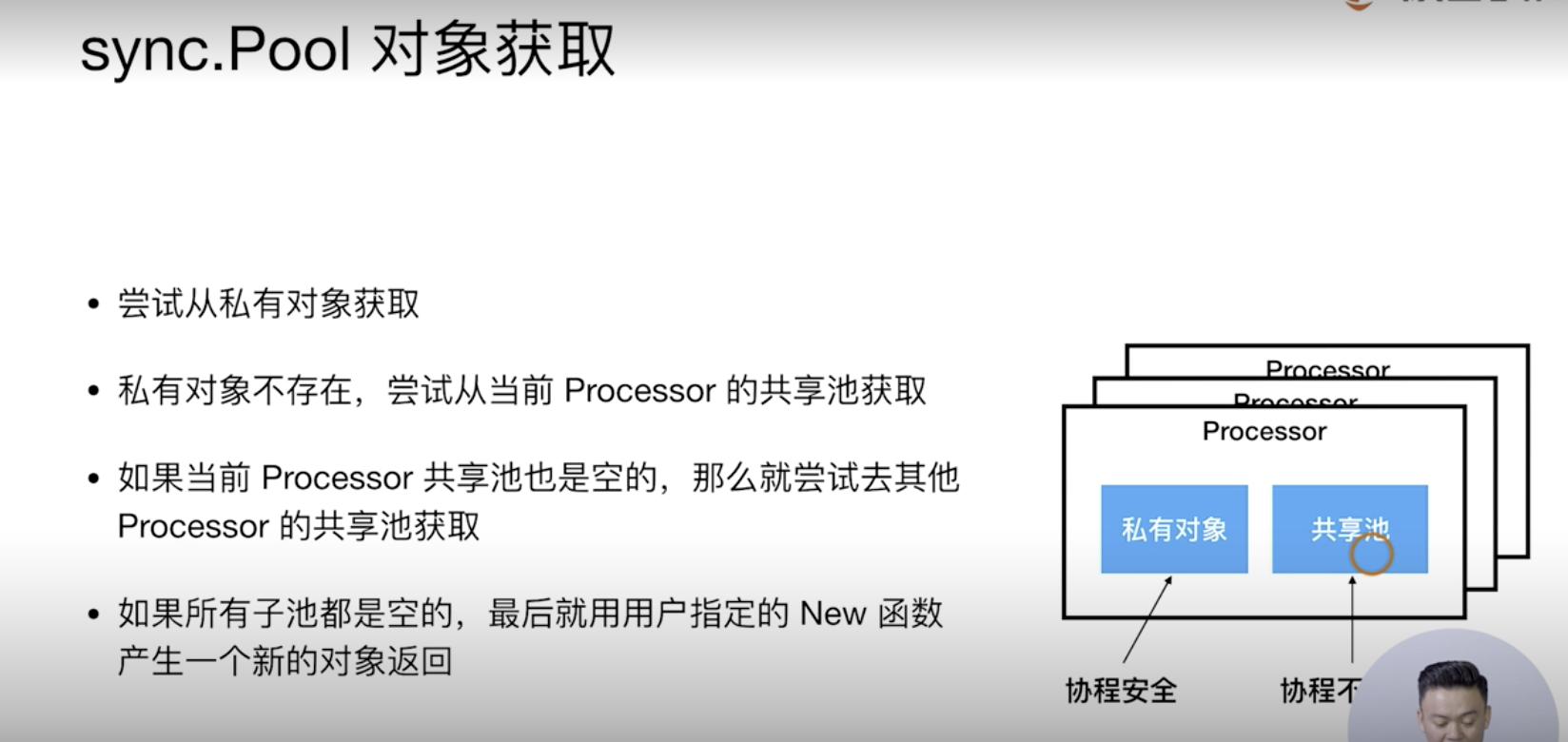## sync.pool
获取对象:

放回对象:

### sync.Pool对象生命周期
* GC会清楚sync.pool缓存的对象
* 对象的缓存有效期为下一次GC之前
### sync.poll适用场景
* 适用于通过复用能降低复杂对象的创建和GC代价
* 协程安全会有锁的开销
* 生命周期受GC影响,不适合做连接池等需要自己管理生命周期的资源的池化
示例:
~~~
func TestSyncPool1(t *testing.T) {
pool := sync.Pool{New: func() interface{} {
obj := 88
fmt.Println("create object:", obj)
return obj
},
}
v := pool.Get().(int)
fmt.Println("Get object :", v)
pool.Put(77) // 取出来后如果不放回,则对象池中为空
runtime.GC() // GC会清楚sync.pool中缓存的对象,注意gc和JAVA中的GC一样,不应该手动调用,此处仅为演示效果
v = pool.Get().(int)
fmt.Println("Get object :", v)
}
func TestSyncPool2(t *testing.T) {
pool := sync.Pool{New: func() interface{} {
obj := 88
fmt.Println("create object:", obj)
return obj
},
}
pool.Put(100)
pool.Put(101)
pool.Put(102)
var wg sync.WaitGroup
for i := 0; i < 10; i++ {
wg.Add(1)
go func() {
obj := pool.Get().(int)
fmt.Println("get object:", obj)
wg.Done()
}()
}
wg.Wait()
}
~~~
- 概述
- go语言基础特性
- Go语言声明
- Go项目构建及编译
- go command
- 程序设计原则
- Go基础
- 变量
- 常量
- iota
- 基本类型
- byte和rune类型
- 类型定义和类型别名
- 数组
- string
- 高效字符串连接
- string底层原理
- 运算符
- new
- make
- 指针
- 下划线 & import
- 语法糖
- 简短变量申明
- 流程控制
- ifelse
- switch
- select
- select实现原理
- select常见案例
- for
- range
- range实现原理
- 常见案例
- range陷阱
- Goto&Break&Continue
- Go函数
- 函数
- 可变参数函数
- 高阶函数
- init函数和main函数
- 匿名函数
- 闭包
- 常用内置函数
- defer
- defer常见案例
- defer规则
- defer与函数返回值
- defer实现原理
- defer陷阱
- 数据结构
- slice
- slice内存布局
- slice&array
- slice底层实现
- slice陷阱
- map
- Map实现原理
- 集合
- List
- Set
- 线程安全数据结构
- sync.Map
- Concurrent Map
- 面向对象编程
- struct
- 匿名结构体&匿名字段
- 嵌套结构体
- 结构体的“继承”
- struct tag
- 行为方法
- 方法与函数
- type Method Value & Method Expressions
- interface
- 类型断言
- 多态
- 错误机制
- error
- 自定义错误
- panic&recover
- reflect
- reflect包
- 应用示例
- DeepEqual
- 反射-fillObjectField
- 反射-copyObject
- IO
- 读取文件
- 写文件
- bufio
- ioutil
- Go网络编程
- tcp
- tcp粘包
- udp
- HTTP
- http服务
- httprouter
- webSocket
- go并发编程
- Goroutine
- thread vs goroutine
- Goroutine任务取消
- 通过channel广播实现
- Context
- Goroutine调度机制
- goroutine调度器1.0
- GMP模型调度器
- 调度器窃取策略
- 调度器的生命周期
- 调度过程全解析
- channel
- 无缓冲的通道
- 缓冲信道
- 单向信道
- chan实现原理
- 共享内存并发机制
- mutex互斥锁
- mutex
- mutex原理
- mutex模式
- RWLock
- 使用信道处理竞态条件
- WaitGroup
- 工作池
- 并发任务
- once运行一次
- 仅需任意任务完成
- 所有任务完成
- 对象池
- 定时器Timer
- Timer
- Timer实现原理
- 周期性定时器Ticker
- Ticker对外接口
- ticker使用场景
- ticker实现原理
- ticker使用陷阱
- 包和依赖管理
- package
- 依赖管理
- 测试
- 单元测试
- 表格测试法
- Banchmark
- BDD
- 常用架构模式
- Pipe-filter pattern
- Micro Kernel
- JSON
- json-内置解析器
- easyjson
- 性能分析
- gc
- 工具类
- fmt
- Time
- builtin
- unsafe
- sync.pool
- atomic
- flag
- runtime
- strconv
- template
